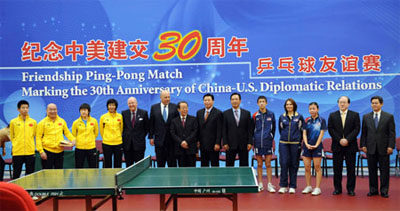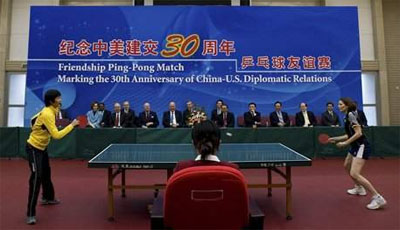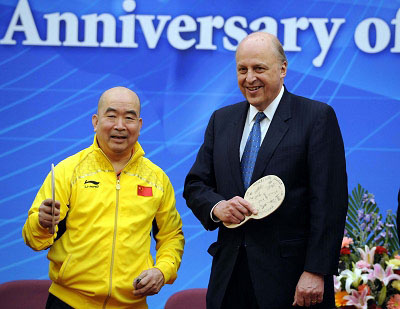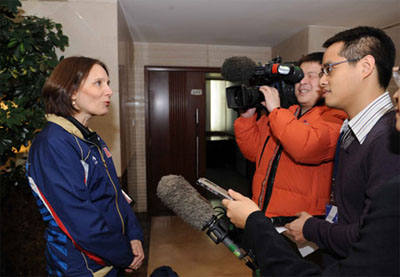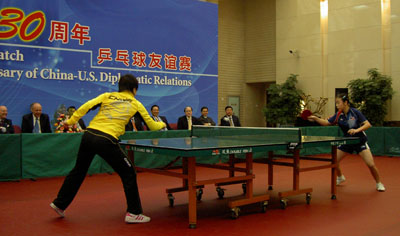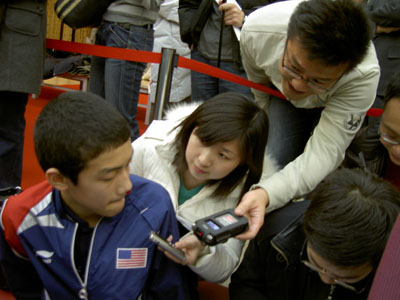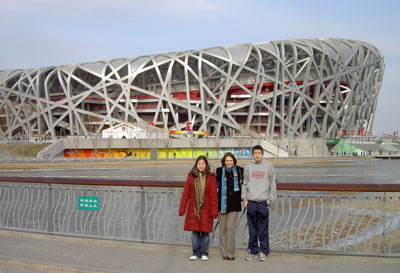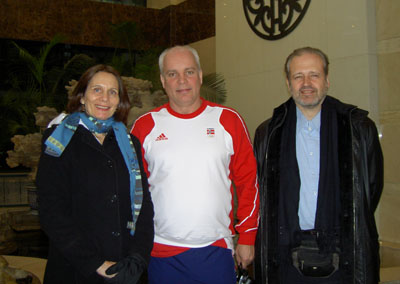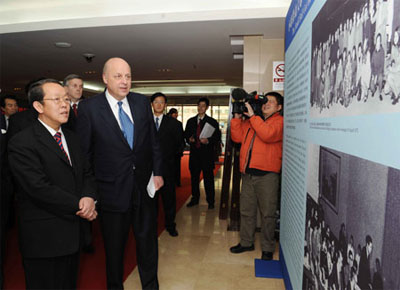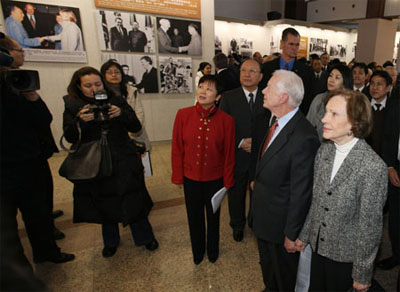|
Table Tennis Plays a Role Once Again:
30th Anniversary of US-China Diplomatic Relations
by Judy Hoarfrost, Ping Pong Diplomat and Paddle Palace owner
“In order to commemorate the 30th anniversary of the Establishment of Diplomatic Relations between China and U.S., the Chinese Table Tennis Association would like to host a friendly match on Jan. 7, 2009” “We wish the USATT help to see if two veteran players, George Braithwaite and Judy Hoarfrost, could come to the event. In addition, we wish to invite two young players (one male, one female) under the age of 18 to come to the event. The relevant expenses incurred from this trip will be born by the General Sport Administration and the Ministry of Foreign Affairs of People’s Republic of China.” Did I wish to accept this invitation? You bet! So, on this latest assignment of Ping Pong Diplomacy, our small table tennis contingent traveling to China was myself and two exceptional juniors, Ariel Hsing and Peter Li. (Unfortunately, George was not able to renew his passport to travel on short notice.) Ariel, who had recently turned 13, had just won the Runner-Up Women’s Singles Title at the December, 2008 US Nationals in Las Vegas, and she also won the Under Age 21 Women’s Singles. Peter, age 15 and already rated a high 2456, is one of our most promising juniors and (like Ariel) is a member of the US Cadet Team which recently attended the International Cadet Challenge in Helsingor, Sweden. On Monday, Jan. 5th our trio took off from the airport in San Francisco for a nonstop flight to Beijing, arriving Tuesday afternoon with the 16-hour time difference. Meeting us at the airport was June Zhu from the Chinese Table Tennis Association. I had met June in China in 2007 when she accompanied a large group of us for the 35th Anniversary Celebration of Ping Pong Diplomacy. She remembered my daughters from that trip, and smilingly recalled that my daughter Adrienne and I had modeled alongside China’s top supermodels in an International Fashion Show at the Beijing Hotel. June took us to the beautiful Tiantan Hotel, which was conveniently located across the street from the venue for the Friendship Matches. Our Day of Diplomacy began with a morning visit to the US Embassy. This is the 2nd largest US Embassy in the world. Ingrid Larson, Public Diplomacy Officer for the Embassy, told us that this beautiful new Embassy building was only just recently opened this year and the Embassy workers are very proud of the facility and happy that the Embassy is now large enough to house all of the departments and personnel which before had been spread out to many locations around Beijing. First we were interviewed by China News Service, one of the two largest news groups in China, the other being Xinhua News Agency, the government sponsored agency that was the sole Chinese news entity that existed back when I first visited China in 1971. Then we had a video interview by qq.com. This is the largest internet provider in China, the world’s ninth largest web property, and the world’s third largest IM provider. We were told that our interview would be viewed by over ten million viewers. Ariel and Peter were excited by this interview, since they were familiar with qq. First, I was questioned in English, but when Ariel and Peter were interviewed the language switched to Chinese as the interviewer discovered they are both fluent. Later on, when Ariel and Peter searched for the interview at qq.com it proved to be too daunting a task, as the whole home page is covered in Chinese characters. Their fluent Chinese language skills are primarily in the verbal, not written, range. Next, we were ushered into a large foyer where a table was set up with many Embassy personnel gathered around, some looking down from walkways on the upper levels of the multi-storied building. Dan Picutta, Deputy Chief of Mission for the Embassy, in his introduction said grandiosely, “The reason the Embassy is here today is because of Ping Pong Diplomacy. All of us working here today owe our jobs to the table tennis players who broke the ice of Diplomatic Relations in 1971.” Chatting personally to me, Dan Picutta said that he remembered well when our team went to China. He said it was the reason he decided to learn about China and go into this line of work. He was 15 at that time, same age as I was. It was nearly 38 years ago that our US Table Tennis Team received the invitation to visit China while we were attending the 1971 World Championships in Nagoya, Japan. Eight years later, in January of 1979 during President Carter’s term of office, our countries established full diplomatic relations. After a nice buffet lunch at the Tiantan hotel, we walked across the street to the State General Administration of Sport Building for the main event. A photo exhibition with large blown-up black-and-while photos of our 1971 Ping Pong Diplomacy trip to China greeted us in the foyer, along with masses of reporters. It was a whirlwind of interviews and cameras – NBC, Associated Press, China News Agency, Xinhua News Agency, and more. Every time I have visited China it has been in a Ping Pong Diplomacy role—the original 1971 Ping Pong Diplomacy trip, the 25th Anniversary of Ping Pong Diplomacy trip, the 35th Anniversary of Ping Pong Diplomacy Trip, a visit in 2008 for the 110th Birthday Commemoration for Premier Zhou Enlai, and now, this 5th visit. Each re-visit to China brings many of the same questions from reporters. They usual questions are: “Were you afraid when you received the invitation in 1971? Did you understand the significance of your team’s visit?; What did you think of the Chinese people in 1971? What did you think of Premier Chou Enlai? What was the reception you received in USA when you returned from China? What changes do you see now in China compared to then? This last question seems very important to the Chinese, as if they seek validation of the changes for which they are very proud. Although China is still emerging economically, technologically, and politically at lightning speed onto the international arena, it seems that past ghosts of China linger. The reporters were shooed away and we took our places in chairs alongside a table tennis table. Across the way sat U.S. Deputy Secretary of State John D. Negroponte and Chinese Vice Foreign Minister Wang Guangya with other dignitaries. A huge blue backdrop behind them in giant red Chinese and English lettering said, “Friendship Ping-Pong Match, Marking the 30th Anniversary of China-U.S. Diplomatic Relations”. There were four Friendship Matches on the agenda. First was my match with Qi Baoxiang. In China in 1971, I won 3 out of 4 matches, not because I was the better player but because, with the eyes of the world upon us, the philosophy espoused by the Chinese was “Friendship First, Competition Second.” “Friendship First” didn’t carry me far today. As a player, Qi Baoxiang totally outclasses me, she having been the top player for the Chinese National Team winning the 36th World Championships, and having won Women’s Singles in the 5th Asia Championships. She is recently retired as a coach, and I can attest she has not lost it as a player. My task as I saw it was to keep the ball in play as long as possible and to have a good time. Mission accomplished. Next up was Peter vs Xu Xin. Xu Xin, at 15 the same age as Peter, took 4th place in the World Juvenile Championships and was a member of the winning team for the 2008 Thailand International Invitational. This match was a crowd pleaser, going deuce a few times before Xu Xin pulled out the win. Next match was Ariel and Chen Meng. Ariel was excited to play her, since she was familiar with her great accomplishments. Just 15 years old, Chen Meng was a member of the winning team at the 2008 Asia Juvenile Championship. Ariel made us proud. With Ariel’s astounding quickness and fluidity, she and her talented opponent had many exciting, crowd-pleasing points in their close match, with Ariel winning the final point. Mixed doubles was the final match. It mixed China and USA, man and woman, and veteran vs youth: Liang Geliang and Ariel vs Qi Baoxiang and Peter. Liang Geliang was one of my favorite Chinese players from when I played in the 1970’s. He was a member of the Chinese Team at the World Championships in Nagoya, Japan when we received the invitation to China, and he was a member of the Chinese Team in 1972 for the Ping Pong Diplomacy Reciprocal Tour of the Chinese Team to USA. A 5-Time participant of the World Table Tennis Championships, he draws you in with his contagious enjoyment of the game, and his shakehand allround style is always great fun to watch. Just this year in June of 2008 I had the pleasure of seeing him when he participated in the “Ping Pong Diplomacy Rematch” at the Nixon Library in Yorba Linda, CA. He currently works at Beijing University and remains a superstar in China. This was the conclusion of our matches and our part in the celebration of 30 Years of Diplomatic Relations. Over the next several days Beijing continued with a flurry of additional celebratory events. A two-day seminar gathered senior Chinese and American diplomats, current and past, including, among others, former President Jimmy Carter, former Secretary of State Henry Kissinger, and former U.S. National Security Advisors Brent Scowcroft and Zbigniew Brzezinski. Among other ongoing celebrations taking place is a year-long traveling photo exhibition of over 360 photos commemorating US-China Relations. The next morning, Ariel, Peter and I were treated to some sightseeing at the Olympic Park. The kids were thrilled to see the familiar buildings from the 2008 Olympics in Beijing—especially the Birds Nest and Water Cube. June purchased tickets for us to go inside. My husband later asked me what sporting events our tickets had gained us entrance to see. He laughed when I said there were no events taking place. Inside were just loads of Chinese tourists enjoying these spectacular new Chinese monuments. After our morning of sightseeing, Ariel and Peter headed to the airport and back to school, Ariel to San Jose, California and Peter to Baltimore, Maryland. I was not in a rush to go home and I enjoyed two more days in Beijing. My table tennis friend, Sheila O’Dougherty, had connected me up to friends who she knew from working in Kazakhstan. Jennifer and Wayne had moved to Beijing in September with their three kids, aged 6 to 15. They both had offices at the US Embassy—Jennifer is opening up a new USAID office in China and Wayne is the US Embassy Doctor in charge of the health care of US Embassy employees in all of China. They took me to their home in a gated community about a 30 minute drive from my hotel in central Beijing. It was a very beautiful Western-style home, in a neighborhood more similar to an American housing development than normally seen in China, but becoming more and more common. Their neighbors were a mix of Chinese nationals and expats. Before China, Jennifer’s job with USAID had led their family to Kazakhstan where they had met Sheila, to Brazil, and to Senegal. What an amazing life! The next morning I had a two-hour interview at my hotel with a reporter from China Newsweek. Then I spend the rest of the day and evening with Christian Lillieroos. Christian is a member of the new USATT board, and has been involved in table tennis for many years, from Coach for the Texas Wesleyan University to Chairman of International Olympic Paralympics Committee . He has been living and working for a couple years now in China and is currently Standing Director for a private company called the Europe-China Culture & Economy Commission. Christian has a beautiful office next door to the famous shopping area Silk Market. Christian took me to visit the Beijing Shi Cha Hai Sports School. Players of several sports train there, and the school boasts several graduates who became champions, including table tennis stars Wang Tao and Zhang Yining. The school has a hotel and dormitories attached, and a cafeteria where the players take their meals. Chinese table tennis players ages 7 to 15 play here. The most promising players over age 15 move on to another program. Many international players come to visit the school, including our own Ariel Hsing who trained there the last couple summers. The coach remembered Ariel and asked me about her. Christian introduced me to his friend Jan Berner who, as coach of the Norway junior team, had brought a group of juniors to Beijing Shi Cha Hai Sports School for coaching and training. The school had arranged a bus in the evening to take the Norwegian players to the famous Wangfujing shopping area of Beijing, so Christian and I rode along. Wangfujing is large and full of shops and malls. We visited a large sporting goods store where several international table tennis brands were offered. I was surprised to see that the non-Chinese brands were being sold at relatively high prices. And I was impressed that in China I saw table tennis shops all over the city. The next day it was Saturday and I was departing in the afternoon. I treated myself to a morning at the Temple of Heaven, which was only a five minute walk from my hotel. Outside its long walls, a large park surrounds it, and Saturday brought out loads of people enjoying their weekend at the park. Groups were practicing Tai Chi and ballroom dancing. Several gatherings were enjoying performances by singers and musicians. Kids and adults played new (to me) versions of a paddle-ball game, and hacky sack with a feathered ball. I paid extra to go inside the gates of the Temple of Heaven. I remembered my last visit here in 1998 when the crowds gathered around my long-blond-haired, blue-eyed young daughter Adrienne everywhere we went, making it take forever to go anywhere. This time, except for the hawkers selling their souvenirs, I attracted little notice, blending with the mostly Chinese tourists who, like me, were appreciating the beautifully preserved buildings constructed in 1420 AD during the Ming Dynasty. It was a peaceful and beautiful ending to my journey to China. No matter how much China changes, a rich heritage remains.
|

